Introduction to RG11 Cable:
RG11 cable is a type of coaxial cable that is widely used for various applications in telecommunications, audio/video distribution, and data networking. It is known for its robust construction, low signal loss, and high bandwidth capabilities, making it suitable for long-distance communication and high-frequency signal transmission. Here is an overview of RG11 cable:
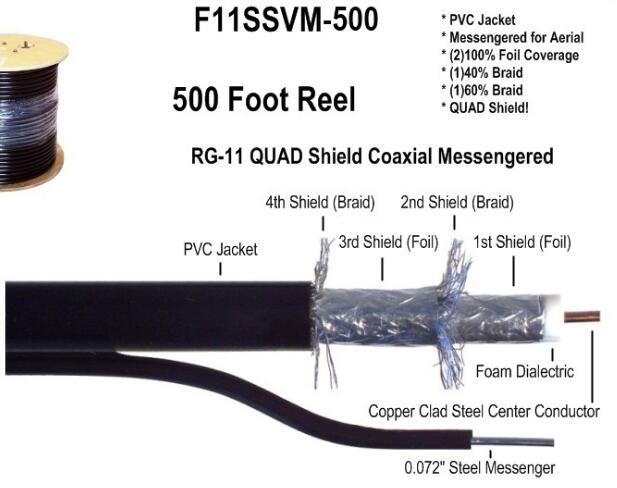
Key Characteristics of RG11 Cable:
-
Construction:
- RG11 cable consists of a solid or stranded copper inner conductor surrounded by a dielectric insulating material, a braided or foil shield, and an outer PVC or PE jacket.
-
Size and Diameter:
- RG11 cable is larger in diameter compared to RG6 and RG59 cables, with a standard diameter of around 0.405 inches.
-
Impedance:
- Typically designed with a characteristic impedance of 75 ohms, suitable for high-frequency applications.
-
Shielding:
- Features multiple layers of shielding to minimize signal interference and maintain signal integrity over long distances.
-
Applications:
- Cable TV Distribution: Used for carrying cable television signals over long distances with minimal signal loss.
- Satellite TV: Ideal for satellite TV installations due to its ability to transmit high-frequency signals effectively.
- Broadband Internet: Employed for distributing high-speed Internet signals in residential and commercial applications.
- Long-Range Communication: Suitable for long-distance communication applications that require minimal signal degradation.
-
Signal Loss and Attenuation:
- RG11 cable offers lower signal loss and attenuation compared to RG6 and RG59 cables, making it suitable for longer cable runs.
-
Weather Resistance:
- Designed to withstand outdoor environments and harsh weather conditions, making it suitable for aerial and buried installations.
-
Connectors:
- Utilizes F-type connectors for cable TV and satellite installations, providing secure connections and good signal transmission.
-
Compatibility:
- RG11 cable is compatible with various audio/video equipment, networking devices, and telecommunications infrastructure.
Benefits of RG11 Cable:
- Low Signal Loss: Provides minimal signal degradation over long distances, maintaining signal quality.
- High Bandwidth: Capable of transmitting high-frequency signals with high data throughput.
- Durable Construction: Resistant to environmental factors, mechanical stress, and electromagnetic interference.
- Versatility: Suitable for a wide range of applications in residential, commercial, and industrial settings.
- Reliable Performance: Ensures stable and consistent signal transmission for critical communication needs.
Conclusion:
RG11 cable is a reliable and high-performance coaxial cable commonly used in various communication and networking applications that demand efficient signal transmission over extended distances. Its robust construction, low signal loss characteristics, and high bandwidth capacity make it a preferred choice for installations requiring resilient and high-quality signal transmission. By understanding the features and applications of RG11 cable, users can confidently deploy it in diverse settings to meet their communication and connectivity requirements effectively.
The Specification of RG11 Cable
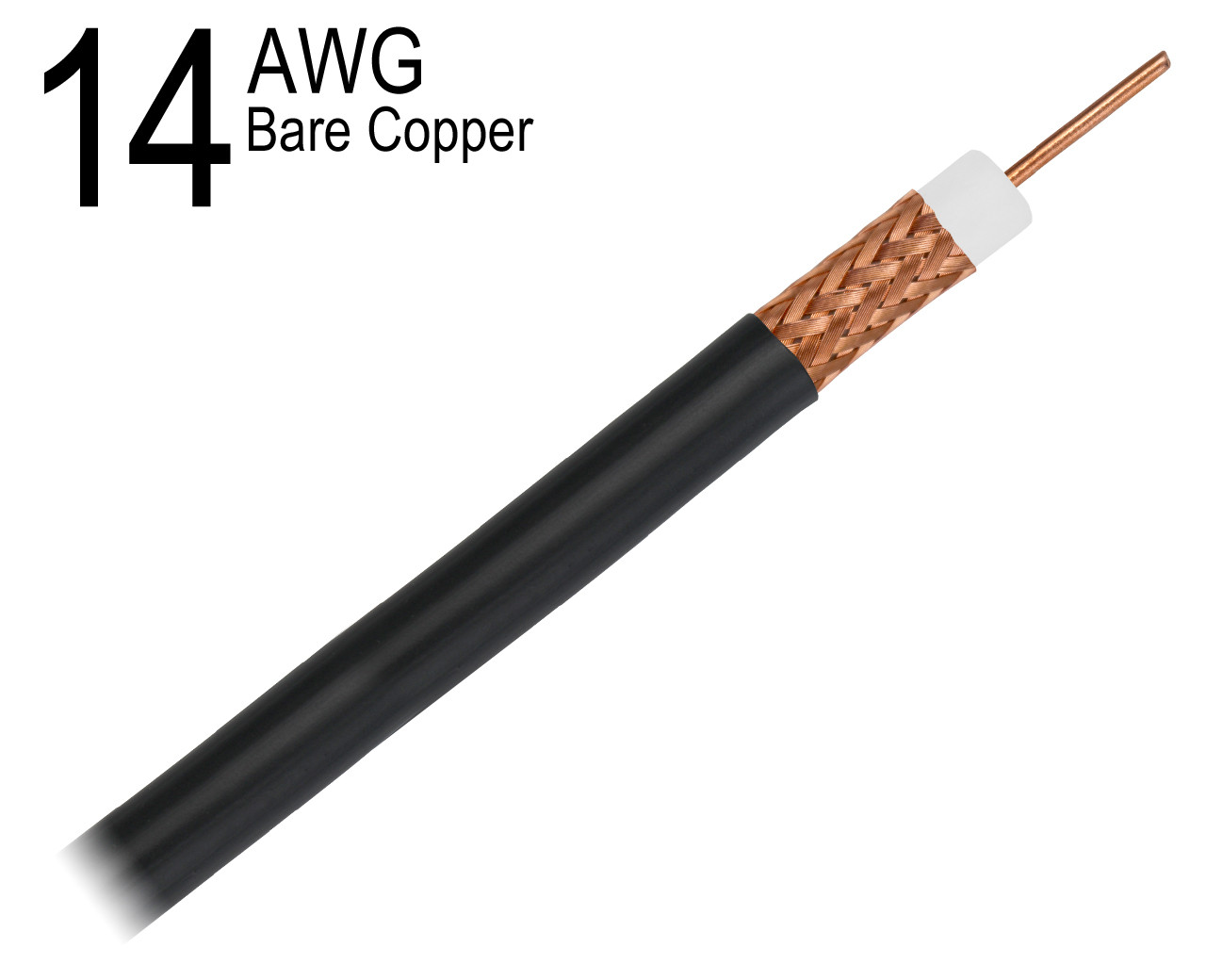
RG11 cable is a type of coaxial cable with specific technical specifications that define its performance characteristics and suitability for various applications. Here are the typical specifications of RG11 cable:
Physical Specifications:
- Conductor Material: Copper or copper-clad steel (CCS) for the inner conductor.
- Inner Conductor Diameter: Typically around 0.064 inches (1.63 mm).
- Dielectric Material: Foam Polyethylene (FPE) for the insulating material around the inner conductor.
- Outer Conductor/ Shielding: Aluminum foil and/or braided shield.
- Outer Conductor Coverage: Usually 60-95% coverage for the braided shield.
- Jacket Material: Polyvinyl Chloride (PVC) or Polyethylene (PE).
- Jacket Color: Usually black, white, or gray.
- Outer Diameter: Approximately 0.405 inches (10.29 mm) or larger.
- Maximum Operating Temperature: Typically rated between -20°C to 75°C.
Electrical Specifications:
- Impedance: Standard 75 ohms impedance for RG11 cable.
- Capacitance: Typically around 16.2 pF/ft.
- Velocity of Propagation: Typically 85%.
- Nominal Attenuation:
- @ 50 MHz: ~1.7 dB/100 ft
- @ 100 MHz: ~2.5 dB/100 ft
- @ 400 MHz: ~5.5 dB/100 ft
- @ 1000 MHz: ~10.2 dB/100 ft
- Operating Frequency Range: Suitable for frequencies up to 3 GHz or higher.
- Minimum Bend Radius: Typically 6 times the cable diameter for flexing applications.
Environmental and Mechanical Specifications:
- Operating Temperature: Generally rated for outdoor and indoor use within a specific temperature range.
- UV Resistance: Some versions may be UV-resistant for outdoor installations.
- Waterproofing: May include gel-filled versions for moisture protection in outdoor applications.
- Pulling Strength: Designed to withstand a certain amount of pulling force during installation.
- Crush Resistance: Able to withstand a specified amount of pressure without significant damage to the cable.
Compliance and Certification:
- Compliance: RG11 cables may adhere to industry standards like ANSI/SCTE, RoHS compliance, UL listing, or other relevant standards.
- Certification: Check for certifications indicating compliance with specific standards for quality and safety.
Application:
- RG11 cables are commonly used in:
- CATV (Cable TV) distribution networks.
- Satellite TV installations.
- High-speed Internet applications.
- Long-distance communication.
- Networking and telecommunications infrastructure.
By considering these specifications, users can select and install RG11 cables optimally for their specific applications, ensuring reliable signal transmission and system performance. Always refer to the manufacturer's datasheet or product specifications for detailed information on a particular RG11 cable variant.
What Is Rg11 Cable Used for
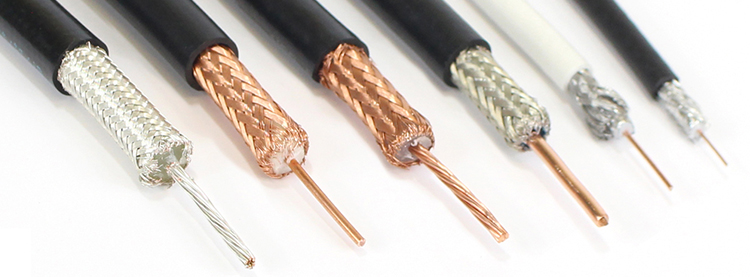
RG11 cable is used for various high-performance applications that require reliable signal transmission over long distances and in environments where signal integrity is crucial. Here are some common uses of RG11 cable:
1. CATV (Cable TV) Distribution:
- RG11 cables are widely used in cable television distribution systems to carry television signals from the service provider to residential and commercial buildings. The low signal loss and high bandwidth capabilities of RG11 make it ideal for long-distance signal transmission in CATV networks.
2. Satellite TV Installations:
- RG11 cables are commonly used in satellite TV installations to connect satellite dishes to satellite receivers. The high-frequency capabilities of RG11 enable the efficient transmission of satellite signals, ensuring a clear and reliable TV viewing experience.
3. Broadband Internet Distribution:
- In broadband Internet applications, RG11 cables are used to transmit high-speed data signals from the Internet service provider to homes and businesses. The low signal loss of RG11 ensures that high-speed Internet services can be delivered efficiently over long cable runs.
4. Networking and Data Communication:
- RG11 cables are utilized in data networking applications, such as Ethernet networks and telecommunications infrastructure, where high-speed data transmission is essential. RG11 cables can support high data rates and long-distance connectivity, making them suitable for networking installations in various settings.
5. Long-Distance Communication:
- Due to its low signal loss and high bandwidth capabilities, RG11 cable is employed in long-distance communication systems where maintaining signal integrity over extended distances is critical. This includes applications such as long-range video surveillance, industrial control systems, and remote monitoring.
6. Antenna Installations:
- RG11 cables are used in antenna installations to connect antennas, such as outdoor TV antennas or radio antennas, to television sets, radios, or other receiving equipment. The durability and weather resistance of RG11 cables make them suitable for outdoor antenna installations.
7. Security Systems:
- RG11 cables are utilized in security and surveillance systems to transmit video signals from security cameras to monitoring stations or recording devices. The reliable signal transmission of RG11 ensures high-quality video feeds in security applications.
8. Telecommunications Infrastructure:
- RG11 cables play a role in telecommunications infrastructure for applications like voice communications, data networking, and high-speed Internet services. They are used in various telecommunications systems to ensure efficient signal transmission and reliable connectivity.
Conclusion:
RG11 cable's robust construction, low signal loss, high bandwidth capacity, and versatility make it suitable for a wide range of applications requiring efficient signal transmission over long distances. Understanding the uses of RG11 cable can help in selecting the appropriate cable type for specific applications and ensuring optimal performance in various communication and networking setups.
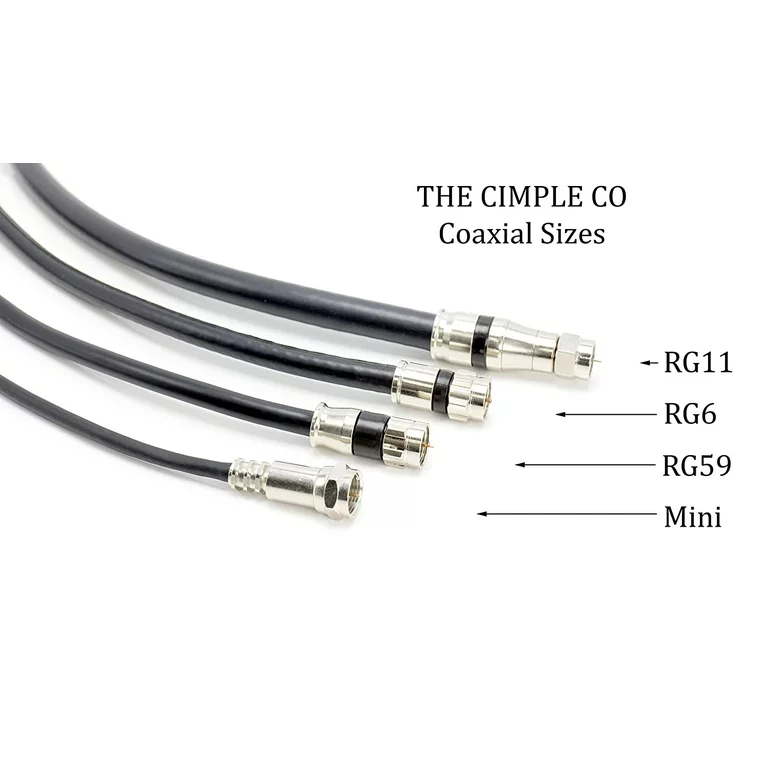
What Is the Difference between Rg6 Cable and Rg11 Cable
|
Diameter |
Approximately 0.275 inches (7 mm) |
Approximately 0.405 inches (10.3 mm) |
|---|---|---|
|
Signal Attenuation |
Higher over long distances |
Lower over long distances |
|
Impedance |
Typically 75 ohms |
Available in both 75 ohms and 50 ohms |
|
Cost |
Generally less expensive |
Generally more expensive |
|
Applications |
Residential installations, short-distance networking |
Larger installations requiring longer cable runs |
RG6 and RG11 cables are both types of coaxial cables commonly used for audio/video, telecommunications, and networking applications. While they share similarities in construction and purpose, there are key differences between RG6 and RG11 cables that affect their performance and suitability for specific applications. Here are the main differences between RG6 and RG11 cables:
1. Size and Diameter:
-
RG6 Cable:
- RG6 cable is thinner and generally has a smaller diameter compared to RG11 cable.
- The diameter of RG6 cable is around 0.275 inches.
-
RG11 Cable:
- RG11 cable is thicker and larger in diameter than RG6 cable.
- The diameter of RG11 cable is approximately 0.405 inches.
2. Impedance:
- RG6 Cable:
- Standard impedance of RG6 cable is 75 ohms.
- RG11 Cable:
- Like RG6, RG11 cable also has a standard impedance of 75 ohms.
3. Signal Loss and Attenuation:
-
RG6 Cable:
- RG6 cable has higher signal loss and attenuation compared to RG11 cable.
- Suitable for shorter cable runs and applications with less demanding signal transmission requirements.
-
RG11 Cable:
- RG11 cable has lower signal loss and attenuation characteristics compared to RG6 cable.
- Ideal for long-distance cable runs and applications where maintaining signal integrity over extended distances is crucial.
4. Bandwidth and Frequency Handling:
- RG6 Cable:
- RG6 cable offers sufficient bandwidth for most residential and commercial audio/video and data networking applications.
- RG11 Cable:
- RG11 cable provides higher bandwidth capabilities and is suitable for applications requiring higher frequency handling, such as in cable TV distribution and high-speed Internet services.
5. Cost:
- RG6 Cable:
- RG6 cables are generally more cost-effective due to their simpler construction and smaller size.
- RG11 Cable:
- RG11 cables are typically more expensive than RG6 cables because of their larger size and higher performance specifications.
6. Applications:
- RG6 Cable:
- Commonly used in residential installations, short cable runs, antenna connections, and other applications where moderate distance signal transmission is required.
- RG11 Cable:
- Used in long-distance communication, CATV distribution systems, satellite TV installations, high-speed Internet services, and applications demanding minimal signal loss over extended cable runs.
Conclusion:
RG6 and RG11 cables are both popular choices for audio/video distribution, networking, and telecommunications applications. The selection between RG6 and RG11 depends on factors such as distance requirements, signal quality considerations, bandwidth needs, and budget constraints. Understanding the differences between these cables can help in choosing the most suitable option for specific installation scenarios and ensuring optimal performance in various communication setups.
Comparison of Rg11 Cable from Different Vendors
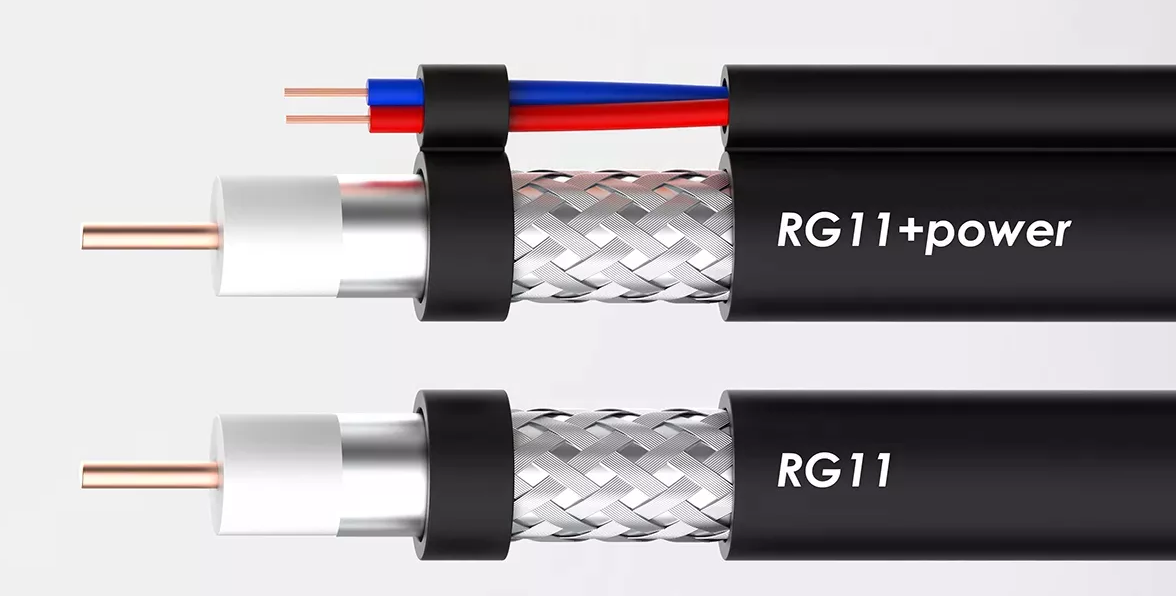
When comparing RG11 cables from different vendors, it's essential to consider various factors to ensure you select the cable that best fits your specific requirements. Here are some key aspects to compare when evaluating RG11 cables from different vendors:
1. Construction and Build Quality:
- Inner Conductor: Check the material (copper or copper-clad steel) and diameter of the inner conductor for conductivity and signal transmission efficiency.
- Shielding: Consider the type (foil, braided, combination), coverage, and material of the shielding to protect against interference.
- Dielectric: Evaluate the quality of the dielectric material for insulation and signal integrity.
- Jacket: Assess the material (PVC, PE) and durability of the jacket for protection against environmental factors.
2. Performance Specifications:
- Impedance: Ensure the cable has a standard 75 ohms impedance for compatibility.
- Signal Loss and Attenuation: Compare the nominal attenuation values at different frequencies to determine signal loss over distance.
- Bandwidth: Check the frequency range supported by the cable for high-speed data transmission.
- Velocity of Propagation: Confirm the velocity rating, typically around 85%, for accurate signal timing.
3. Environmental Considerations:
- UV Resistance: If needed for outdoor use, opt for cables with UV-resistant jackets.
- Weather Resistance: Look for cables designed to withstand harsh weather conditions.
- Moisture Protection: Consider cables with additional moisture protection for outdoor or buried installations.
4. Certifications and Compliance:
- Industry Standards: Verify if the cable meets industry standards like ANSI/SCTE, RoHS compliance, UL listing, or other relevant certifications.
- Quality Assurance: Check for quality control measures and certifications to ensure reliable performance.
5. Price and Value:
- Cost: Compare prices from different vendors while considering the overall value, including performance, durability, and warranty.
- Bulk Discounts: Explore options for bulk purchases if installing multiple lengths of cable.
6. Customer Support and Warranty:
- Vendor Reputation: Research the vendor's reputation for product quality and customer service.
- Warranty: Check the warranty offered by each vendor to ensure protection against defects or performance issues.
7. Reviews and Feedback:
- Customer Reviews: Look for reviews and feedback from other users to gauge the performance and reliability of the cable from different vendors.
- Vendor Reputation: Consider the vendor's overall reputation and customer satisfaction ratings.
Conclusion:
Comparing RG11 cables from different vendors involves assessing construction quality, performance specifications, environmental suitability, certifications, pricing, customer support, and feedback. By carefully evaluating these factors, you can make an informed decision when selecting an RG11 cable that meets your specific requirements for reliable signal transmission and durability in various applications.



